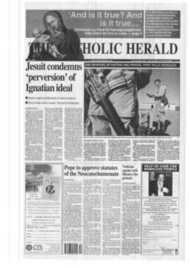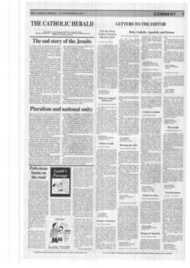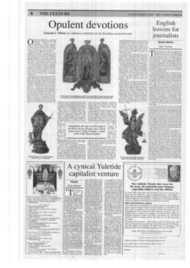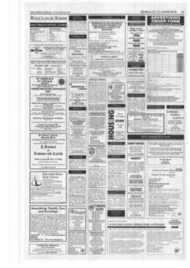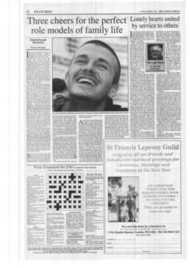Page 9, 14th December 2001
Page 9
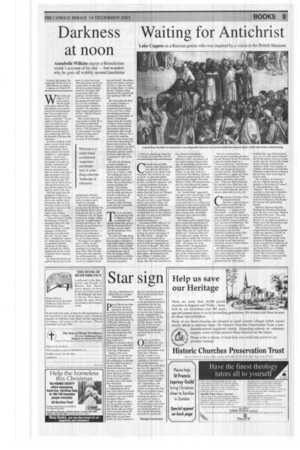
Report an error
Noticed an error on this page?If you've noticed an error in this article please click here to report it.
Tags
Share
Related articles
The Antichrist Is `eco Activist Vegetarian'
Beware Of Antichrist, Cardinal Tells Pope
Lucid Russian Minds Ultimate Questions: An Anthology Of...
Pope Warned About Antichrist
Ratzinger Backs New Journal
Waiting for Antichrist
Luke Coppen on a Russian genius who was inspired by a vision in the British Museum
A Solovyov Anthology, edited by S L Frank, St Austin Press £14.95 CI .... ardinal Giacomo Biffi caused a mild sensation last year when he delivered a
speech on the nature of the Antichrist. The Antichrist, he said, would be "an admirable philanthropist, a committed and zealous pacifist, a dedicated vegetarian" and "a resolute proponent of animal rights". More specifically still, he would have a degree in biblical studies from the faculty of Tiibingen and be an "excellent ecumenist".
The pugnacious Archbishop of Bologna was not, as some thought, taking a pop at Hans Kung. Any resemblance between the former Ttibingen professor and the Antichrist was purely coincidental. Cardinal Biffi was, in fact, riffing on the ideas of a rarely-read 19th Russian philosopher: Vladimir Sergeivich Solovyov.
According to Biffi, Sokwyov (or Soloviev, as some prefer) "understood the 20th century like no one else". Hans Urs Von Balthasar — perhaps the greatest theologian of the 20th century — thought that Solovyov was second only to Thomas Aquinas "as the greatest artist of order and organisation in the history of thought". The editor of the present volume, S L Franks, hails him as "the greatest of Russian philosophers and systematic religious thinkers". Another critic called him "the Russian Newman". Heady stuff. But what did Solovyov do to deserve such plaudits?
Solovyov, who was born in Moscow in 1853, was marked out for religious genius from an early age. His grandfather, an Orthodox priest, consecrated his eight year-old grandson to the service of the Church. A year later. Solovyov received his first blinding vision of a feminine spiritual being who identified herself as Sophia, the living Wisdom of God. This being became the love of his life and the inspiration of his entire philosophical and theological project.
His "eternal friend" appeared to him again, over a decade later, in the unlikely setting of the reading room of the British Museum. She commanded him to go to Egypt and promised to show herself more fully to him there. He duly packed his cases and set off for Africa. In the desert outside Cairo, he had the promised vision, and soon after returned to Russia.
The writers in this volume struggle to explain the significance of these visions. Von Balthasar tentatively identifies Sophia with the Virgin Mary, but also likens her to Beethoven's "Immortal Beloved". S L Franks says, simply, that it is impossible to explain the visions in words. Sophia is "the ideal world in God", "the living soul of the created world", an intermediary between creature and Creator. While her identity remains uncertain, all the commentators agree that Solovyov returned to Russia a different man, gripped by an urgent mission. Solovyov set himself the
awesome task of reuniting the Eastern and Western Church. He devised a plan for reunion based on a "universal theocracy" with the pope as head. Unfortunately, nobody on either side thought his proposal remotely realistic. The Orthodox regarded him as a papist and traitor. Catholics rebuked him for "freethinking, dreaminess and mysticism". Pope Leo X111 summed up the common view: Bella idea, ma fu or d'un miracolo, i cosa impossibile (a beautiful idea but, short of a miracle, impossible to carry out).
Crushed by the failure of his ecumenical dream, Solovyov stopped going to church and developed a highly individualistic brand of Christianity — a "religion of the Holy Spirit" — without visible structures. In those years, he used to joke about himself: "I am supposed to be a Catholic, but as a matter of fact I am more of a Protestant." Yet Solovyov was struggling with a deep sense of foreboding. He sensed the imminent arrival of the Antichrist and did not think Christians were well prepared. He predicted that 99 per cent of priests and monks would side with the Antichrist, because of their fixation with earthly power.
In 1900, Solovyov wrote his final work, the uncannily prophetic Short Story of the Antichrist. This tale, which he described as his "final view of the church problem", predicted that the 20th century would be the "age of the last great wars, of civil strife and revolutions". Out of this turmoil, Solovyov wrote, would come the Union of the United States of Europe, beaded by the Antichrist. Only a tiny minority of Catholics, Protestants and Orthodox Christians would refuse to submit to him and thus usher in the reign of God on earth.
The Antichrist, in Solovyov's tale, has a Blairite persona. He preaches a Christianity of "values", of "openmindedness" and "dialogue". He reduces Christ's teaching to a message of tolerance and humanitarian action. He is a convinced idealist, labouring tirelessly for world peace. He disarms his enemies with spellbinding rhetoric.
Solovyov died not long after finishing his disturbing final testament. His last words were: "Hard is the work of the Lord." Two icons were placed on his grave in Moscow by an unknown admirer: a Greek icon of the Resurrection and a Catholic icon of Our Lady.
Saint Austin Press must be congratulated for bringing together a judicious selection of works on and by Solovyov, including an important appendix on the vexed question of whether the Russian mystic converted to Catholicism (it seems he didn't). This new anthology brings Solovyov's brilliant writings and curious personality back to life. It should be read by anyone wishing to understand this most powerful and original of thinkers.
blog comments powered by Disqus


